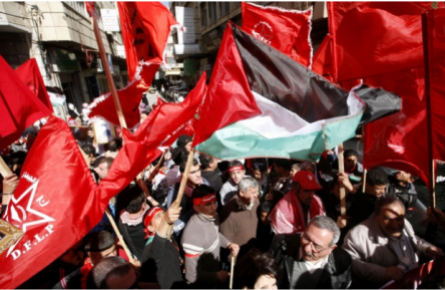A public opinion poll released last week revealed a widening gap between Palestinian leaders and their constituents. Rapid domestic and regional developments in recent weeks have caused both the Palestinian Authority and Hamas to take decisive actions to secure their interests. These include drastic financial measures by the Palestinian Authority against the Gaza Strip, political maneuvers by Hamas aimed at navigating the worsening situation in Gaza, and the unfolding Qatar crisis. However, the Palestinian public feels largely sidelined as poll finds overwhelming opposition to nearly all steps taken by the Palestinian Authority and Hamas.
THE SALARIES AND ELECTRICITY CRISES
In April, 2017, the Palestinian Authority decided to the cut the salaries of its public employees in the Gaza Strip by up to 70 percent. This drastic measure was followed by a decision, announced in early June, 2017, to no longer finance Gaza’s electricity supply, which left nearly two million Palestinians with only an average of three hours of power. Although the Palestinian Authority said these decisions were taken due to a worsening financial situation caused by declining rates of foreign aid, the numbers suggest otherwise. In fact, the Palestinian Authority has been enjoying the highest tax revenue streams in its history, and Gaza has generated a substantial portion of these returns. Most recently, the Palestinian Authority has been accused of delaying medical transfer requests for conditions that needed treatment abroad.
Almost immediately, the impact of these decisions was widely felt across the besieged Gaza Strip. Short of cash because of the salary cuts, many people were left unable to support their families. The crisis hit hardest in the medical sector. With an extremely limited electric supply, and shortages of fuel for generators, hospitals were forced to operate at a minimal level, and given the delays in processing transfer requests, at least three infants died waiting for permits to be transferred elsewhere.
It should be no surprise that these conditions have made the Palestinian Authority’s decisions overwhelmingly unpopular, with 84% opposed to the measure on Gaza’s electric supply and 88% opposed to the salary cuts, the poll found.
THE HAMAS-DAHLAN “UNDERSTANDINGS”
For Hamas in Gaza, these conditions, coupled with a regional storm hitting its strongest ally, Qatar, have led to an unlikely opening with Egypt through the mediation of Mohammed Dahlan’s, former Fatah security chief for the Gaza Strip. Rattled by Abbas’ ability to tighten the noose on Gaza, Hamas has been compelled to pursue a friendlier line with its former archenemy Dahlan, who enjoys good relations with a number of Gulf countries and Egypt.
Extensive speculation has followed a meeting in Cairo in early June, 2017, between the newly appointed Hamas chief in Gaza, Yahya Sinwar, and Dahlan. Ismail Haniyeh, the head of Hamas’ politburo, said in a speech he delivered on July 5, 2017, that relations with Egypt have been improving since then.
However, concerned with achieving inter-Palestinian reconciliation rather than being embroiled in regional affairs, 50% of those polled fear that a Hamas-Dahlan agreement buttressed by Egypt would lead to a complete separation of the Gaza Strip from the West Bank, while 60% in the Gaza Strip oppose such an agreement compared to only 29% in the West Bank, according the poll.
HAMAS’ NEW PLATFORM
Hamas announced a new platform on May 1, 2017, in the hope that it would address the shortcomings of its original founding document and enable it to navigate an increasingly shifting regional order. Though the document raised eyebrows in certain circles for its far more moderate tone compared to the original Hamas platform, a majority of Palestinians had not heard about it, the poll found.
THE QATAR CRISIS
There is no doubt that the Qatar crisis has been central in the calculations of Hamas and the Palestinian Authority. For the former, the crisis meant seeking other sources of financial support and regional political cover, while for the latter it meant insulating and securing its position, all while ensuring that Hamas remains within its sphere of influence.
In line with their longstanding practice, neither the Palestinian Authority nor Hamas announced an official position on the Qatar crisis. However, it is not difficult to imagine where each stands.
The Palestinian Authority likely supports the Saudi-led measures against Qatar in the hope that they would lead to a resolution of outstanding issues with Egypt, notably the arrangements for control of the Rafah Crossing. This would sideline the Hamas-Dahlan understandings, which include an arrangement of their own for the crossing with Egypt.
The situation is more precarious for Hamas as it tries to maintain ties with both Saudi Arabia and Qatar. In fact, Haniyeh made sure to explicitly and equally thank both nations for their support in his July 5 speech. It is not clear whether Egypt will ask Hamas to sever its ties with Qatar in return for greater easing of restrictions on Gaza and implementing the understandings reached through Dahlan’s mediation.
Meanwhile, according to the poll, two thirds of Palestinians oppose the Saudi-led measures against Qatar.
WHAT NOW?
The findings clearly indicate a widening gap between Palestinian leaders and their constituents. Palestinians are far more concerned with the situation on the ground than with political alliances and polemic ideological statements. Both the Palestinian Authority and Hamas would be wise to take measures to resolve the rapidly deteriorating situation in Gaza.




